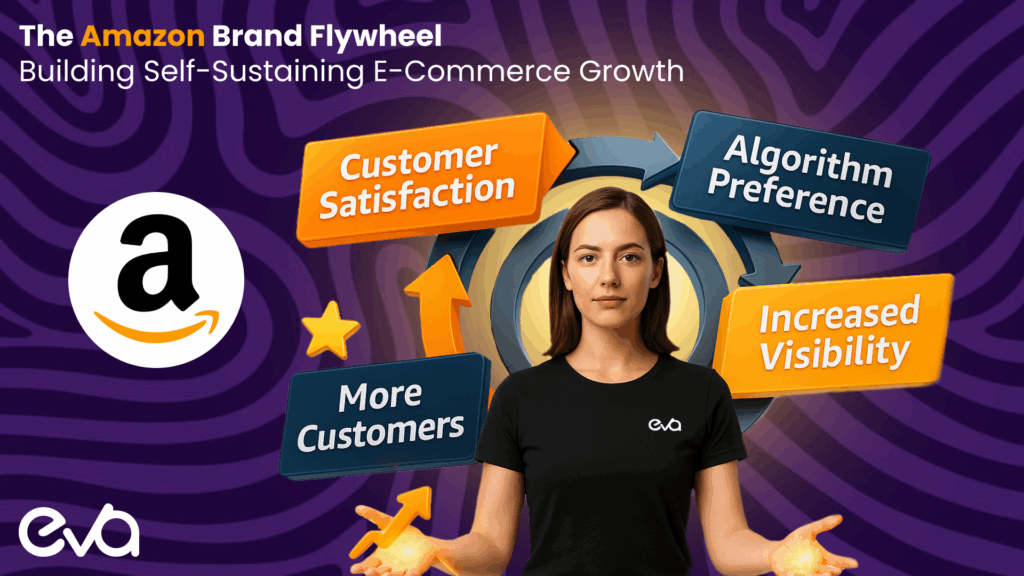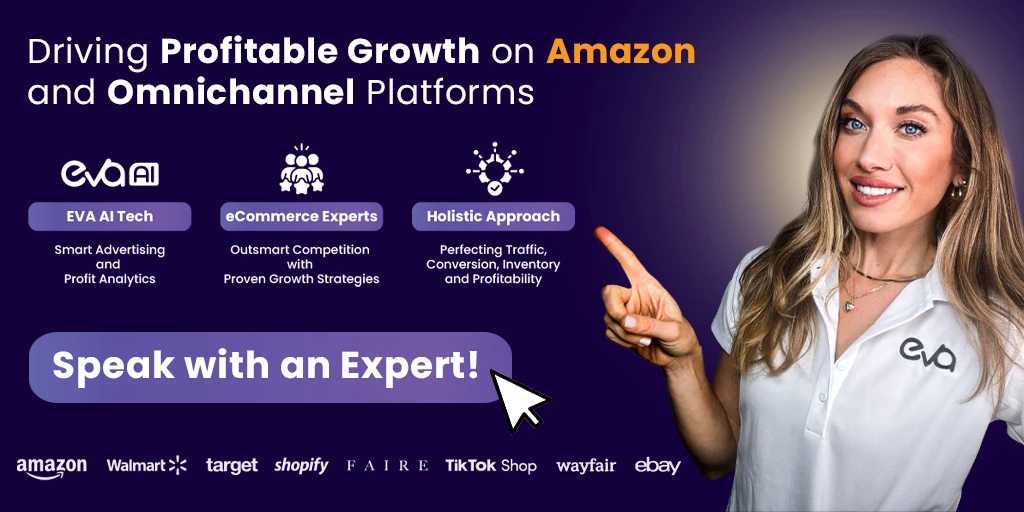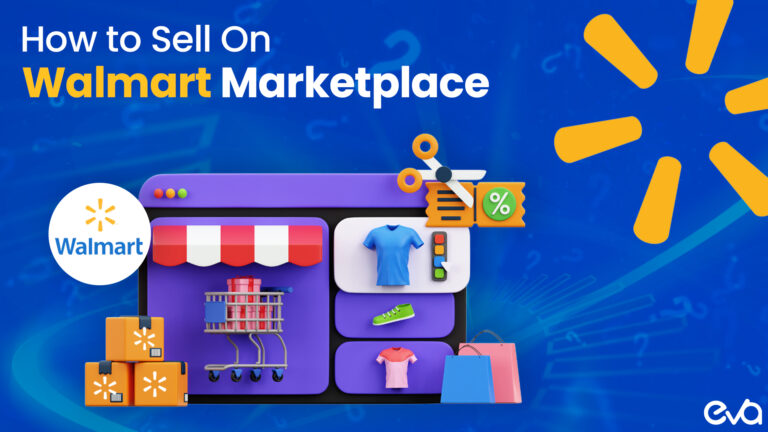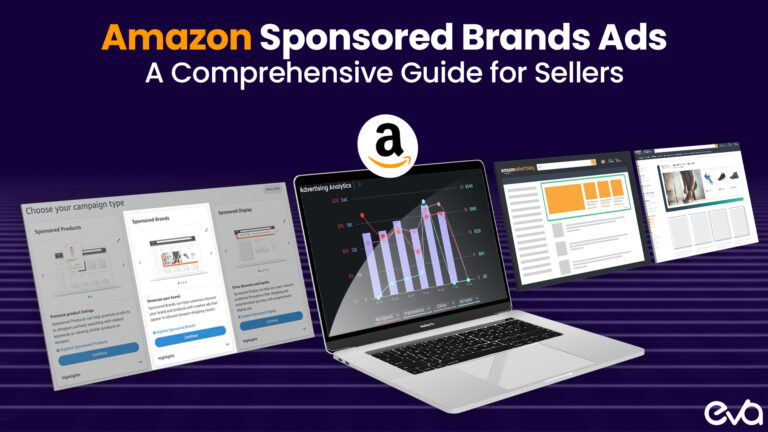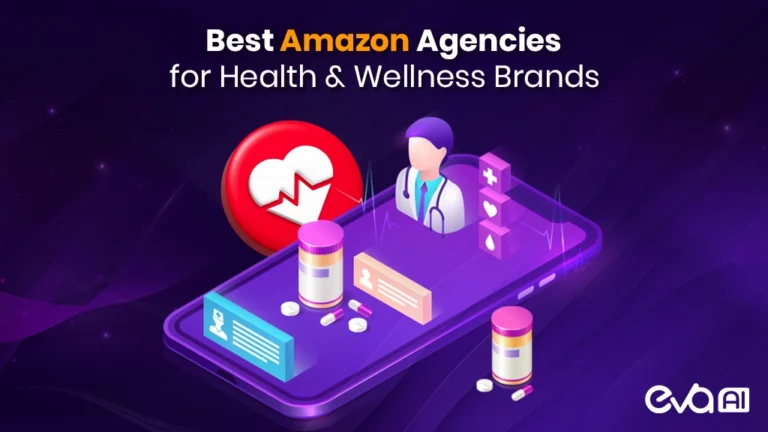Amazon’s most successful brands understand a fundamental truth: sustainable growth isn’t about optimizing individual tactics – it’s about creating momentum that feeds on itself.
The Brand Flywheel concept represents this self-reinforcing cycle where customer satisfaction drives algorithmic preference, which increases visibility, leading to more customers and even greater satisfaction.
Think of it like a massive wheel that’s difficult to get spinning initially, but once it gains momentum, it becomes nearly unstoppable. Each positive customer interaction adds energy to the wheel, making it spin faster and with less effort required from you.
The brands breaking through from six-figure monthly revenue to seven-figure dominance have mastered this principle. They’ve stopped chasing quick wins and started building systems that create inevitable growth.
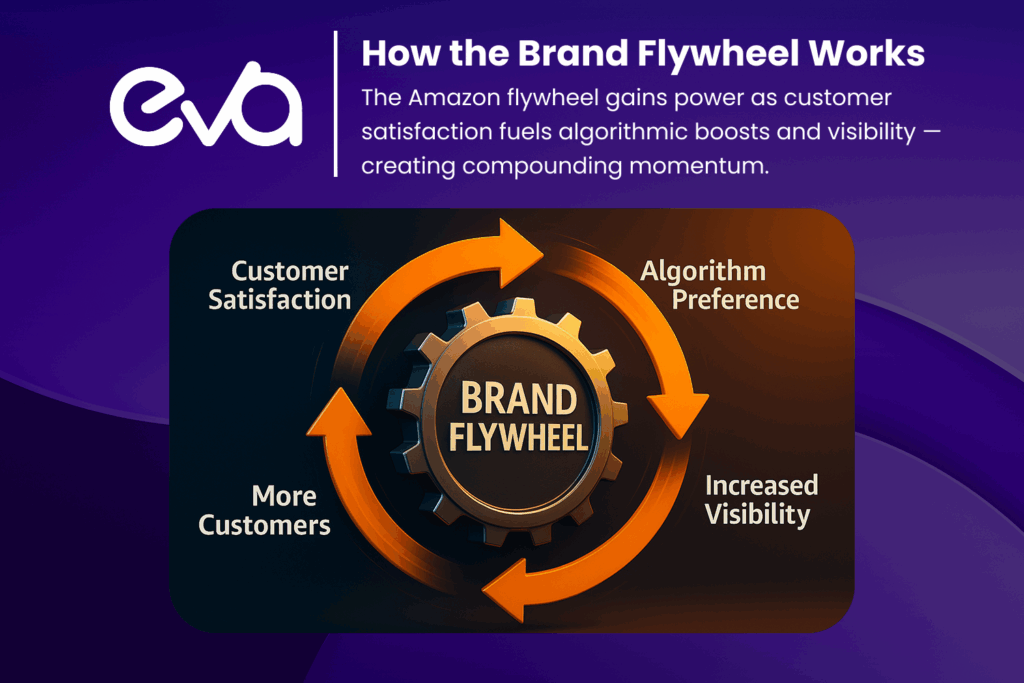
Table of Contents
- Understanding Amazon’s Customer-First Philosophy
- The Three Phases of Flywheel Development
- Real-World Flywheel Success: “EcoClean” Case Study
- The Technology Requirements for Flywheel Success
- Common Flywheel Pitfalls and How to Avoid Them
- Advanced Flywheel Strategies for Enterprise Sellers
- Measuring Flywheel Health
- Professional Flywheel Implementation
- Eva: Your Partner for Advanced Flywheel Strategy
Understanding Amazon’s Customer-First Philosophy
Amazon’s A10 algorithm operates on a deceptively simple principle: reward sellers who create the best customer experiences. Every ranking factor, from conversion rates to review quality, ultimately measures how well you satisfy customers compared to your competitors.
This creates an interesting dynamic. While most sellers focus on gaming the algorithm through keyword manipulation or aggressive bidding, the real winners focus on customer obsession. They understand that Amazon’s algorithm doesn’t just measure what you do – it measures how customers respond to what you do.
The Three Pillars of Customer-Driven Growth
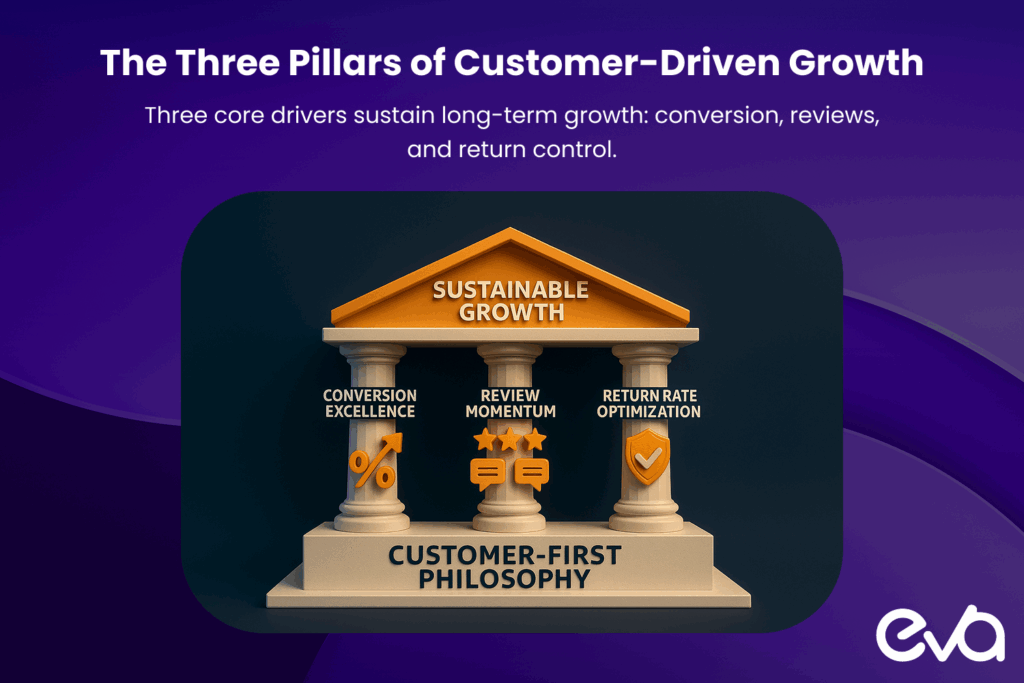
Conversion Excellence Your conversion rate tells Amazon everything it needs to know about product-market fit. High-converting listings signal that customers find exactly what they’re looking for when they visit your product page. This triggers Amazon’s algorithm to show your products to more similar customers.
Top performers maintain conversion rates significantly above category averages through relentless testing of product images, titles, pricing, and content. They understand that a 1% improvement in conversion rate can translate to exponential increases in organic visibility.
Review Momentum Amazon’s algorithm pays attention to both review quality and review velocity. Products gaining positive reviews consistently signal growing customer satisfaction and product momentum. This creates a feedback loop where better rankings lead to more sales, which generate more reviews, improving rankings further.
Smart sellers design their entire post-purchase experience around review generation. From follow-up sequences to product inserts, every touchpoint is optimized to encourage satisfied customers to share their experiences.
Return Rate Optimization Products with low return rates signal accurate product descriptions and consistent quality. Amazon heavily favors products that rarely disappoint customers, as returns create operational costs and customer frustration.
This metric forces sellers to focus on quality control, accurate product descriptions, and realistic customer expectations rather than overpromising to drive initial sales.
The Three Phases of Flywheel Development
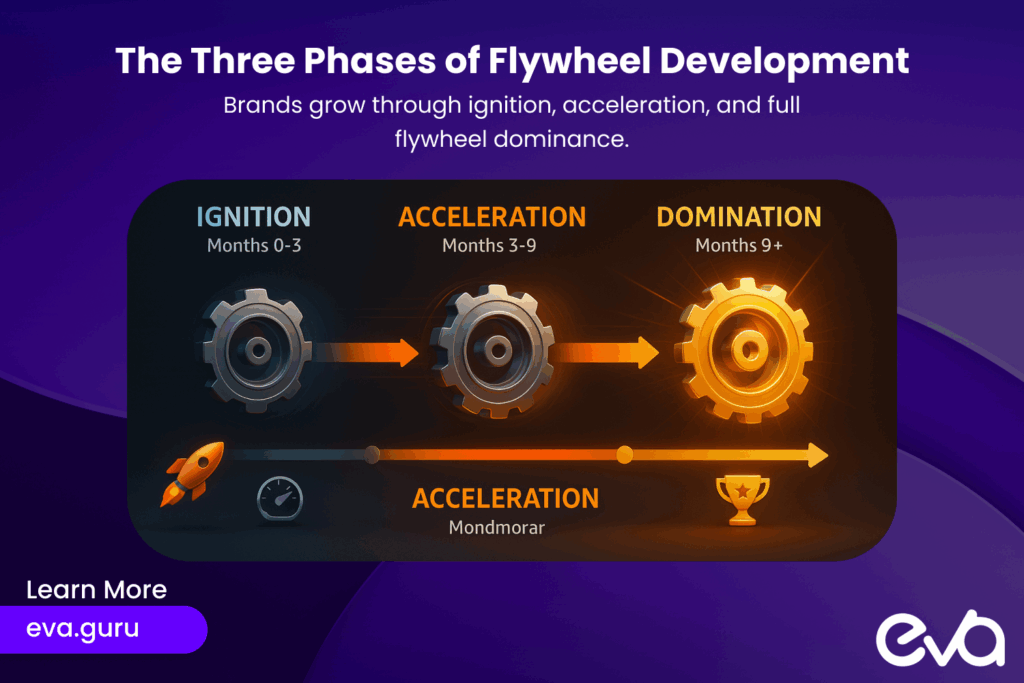
Phase 1: Ignition (Months 0-3)
Getting the flywheel spinning requires focused energy and often short-term sacrifices for long-term momentum.
Building Initial Velocity New products need artificial momentum to overcome the cold-start problem. This might mean temporarily sacrificing margins through competitive pricing, investing heavily in advertising to generate initial sales data, or using programs like Amazon Vine to build review foundations.
The goal isn’t immediate profitability – it’s demonstrating to Amazon’s algorithm that your product satisfies customers. Early metrics matter more than early profits because they determine your long-term organic visibility.
Foundation Setting This phase involves establishing the infrastructure for sustained growth: optimized listings that convert browsers into buyers, inventory systems that prevent stockouts, and advertising campaigns that generate profitable traffic while teaching the algorithm about your ideal customers.
Smart sellers also begin building their external traffic sources during this phase, creating email lists and social media followings that can drive off-Amazon traffic to their listings. This external traffic signals product popularity beyond Amazon’s ecosystem.
Phase 2: Acceleration (Months 3-9)
Once initial momentum builds, the focus shifts to amplifying what’s working and expanding into adjacent opportunities.
Product Line Expansion Successful products create opportunities for complementary launches. Customers who love your primary product become ideal targets for related items, creating cross-selling opportunities that increase lifetime value.
This expansion should follow customer demand signals rather than arbitrary product decisions. Amazon’s Brand Analytics reveals what your customers buy before and after purchasing your products, providing roadmaps for strategic expansion.
Market Share Capture As your flywheel gains speed, you can begin more aggressive competitive strategies. This might include targeting competitor keywords, optimizing for seasonal trends, or expanding into international marketplaces.
The momentum built in Phase 1 provides the foundation for these more ambitious strategies. Higher conversion rates and better review profiles make competitive campaigns more cost-effective.
Phase 3: Domination (Months 9+)
Mature flywheels create self-sustaining competitive advantages that become increasingly difficult for competitors to replicate.
Subscription Integration Amazon’s Subscribe & Save program creates predictable revenue streams while signaling customer loyalty to the algorithm. Subscribed products rank higher because they guarantee future sales, creating algorithmic preference that compounds over time.
Building subscription adoption requires products naturally suited to repeat purchase and customer education about convenience and savings benefits.
Brand Authority Development Established products can leverage Amazon’s brand-building tools like Storefronts and A+ Content to create comprehensive brand experiences. These tools increase customer engagement and average order values while reinforcing brand recognition.
Brand authority also enables premium pricing strategies that improve margins without sacrificing conversion rates. Customers pay more for brands they trust and recognize.
Real-World Flywheel Success: “EcoClean” Case Study
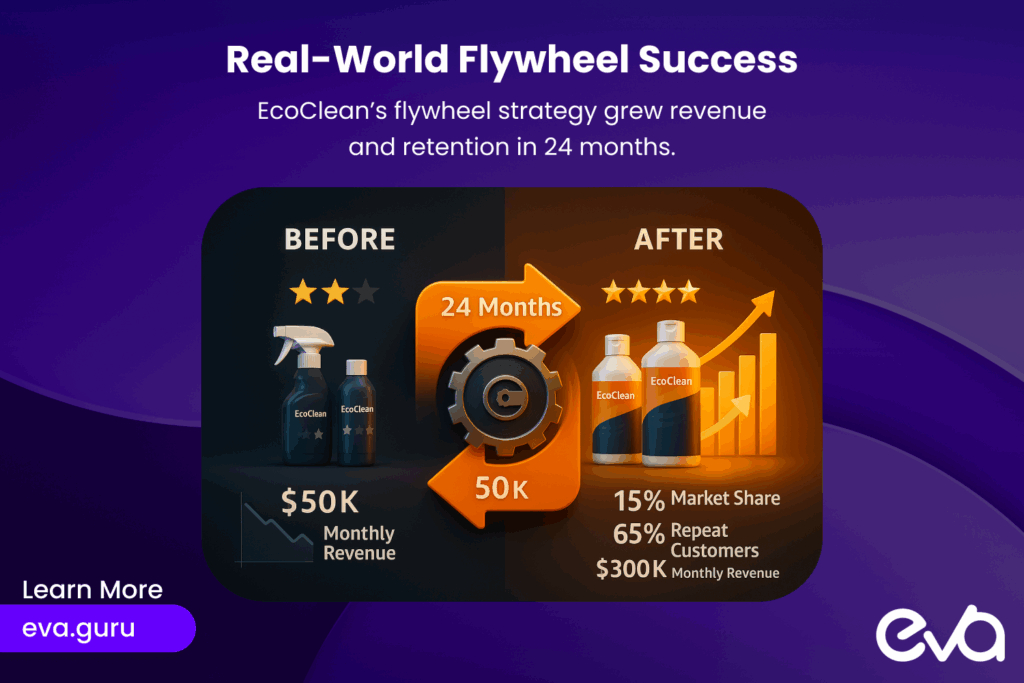
Background: A new cleaning products brand entering a market dominated by century-old household names with massive advertising budgets and distribution networks.
Phase 1 Strategy (Months 1-3) Rather than compete head-to-head with established brands, EcoClean focused on a specific customer segment: environmentally conscious families with young children. Their initial investment of $15,000 targeted this niche through:
- Vine reviews emphasizing safety and environmental benefits
- Content marketing that educated customers about harmful chemicals in traditional cleaners
- Influencer partnerships with parenting and environmental bloggers
Results: 4.6-star average rating across their initial three products, with 200+ reviews demonstrating clear product-market fit within their target segment.
Phase 2 Expansion (Months 3-9) With proven demand, EcoClean expanded strategically:
- Launched complementary products based on customer feedback and search data
- Developed subscription bundles that increased customer lifetime value by 40%
- Expanded into related categories like eco-friendly laundry and personal care
Results: Grew from 3 to 12 SKUs while maintaining 4.5+ star ratings across all products. Monthly revenue increased from $50K to $300K.
Phase 3 Leadership (Months 9+) EcoClean’s flywheel momentum enabled market leadership strategies:
- Premium pricing that improved margins while maintaining growth
- Brand partnerships with environmental organizations
- International expansion using proven US success as validation
Final Results: Achieved 15% market share in their primary category within 24 months, with 65% of revenue coming from repeat customers and subscriptions.
The Technology Requirements for Flywheel Success
Flywheel optimization requires sophisticated data analysis and automation that goes beyond basic seller tools.
Data Integration Needs
Successful flywheel management requires connecting data from multiple sources: Amazon’s native analytics, external traffic sources, inventory management systems, and customer service platforms. This integration reveals the complete customer journey and identifies optimization opportunities.
Automation Requirements
Manual flywheel management becomes impossible at scale. Automated systems handle:
- Dynamic pricing adjustments based on conversion optimization rather than simple competitor matching
- Inventory forecasting that prevents stockouts while minimizing storage costs
- Advertising bid adjustments that respond to real-time conversion data
Performance Attribution
Understanding which activities drive flywheel momentum requires sophisticated attribution modeling. This reveals how advertising, content optimization, and customer service improvements contribute to organic growth.
Common Flywheel Pitfalls and How to Avoid Them
Focusing on Vanity Metrics Many sellers optimize for metrics that don’t drive flywheel momentum: total sales without regard to profitability, keyword rankings without conversion consideration, or review quantity without quality focus.
Successful flywheel development requires discipline to focus on metrics that actually predict long-term success: customer lifetime value, organic conversion rates, and repeat purchase behavior.
Neglecting Customer Experience The temptation to cut costs on customer service, shipping speed, or product quality can derail flywheel momentum quickly. Negative experiences spread faster than positive ones and can reverse months of progress.
Impatience with Timeline Flywheel development takes time, and many sellers abandon the strategy before seeing results. The most successful brands commit to 12-18 month timelines for achieving significant momentum.
Advanced Flywheel Strategies for Enterprise Sellers
Multi-Brand Portfolio Management Large sellers can create flywheel synergies between different brands, using successful products to launch complementary brands in adjacent categories. This strategy amplifies the flywheel effect across multiple product lines.
International Flywheel Replication Once domestic flywheel momentum is established, successful sellers can replicate their strategies in international markets, leveraging proven products and customer insights to accelerate growth in new regions.
Platform Diversification Strong Amazon flywheels create opportunities for expansion to other platforms like Walmart, Target+, or direct-to-consumer channels. The brand recognition and customer insights developed on Amazon transfer to new platforms.
Measuring Flywheel Health

Leading Indicators
- Customer Lifetime Value trends
- Review velocity and sentiment
- Organic traffic growth rates
- Conversion rate improvements over time
Lagging Indicators
- Market share growth
- Profit margin expansion
- Subscription adoption rates
- Brand search volume increases
Warning Signs
- Declining review ratings despite stable sales
- Increasing customer acquisition costs
- Growing return rates
- Stagnant repeat purchase behavior
Professional Flywheel Implementation
Creating sustainable flywheel momentum requires more than understanding the concept – it demands systematic execution across multiple business functions. The most successful brands treat flywheel development as a core business strategy, not a marketing tactic.
For sellers generating substantial revenue, the complexity of flywheel optimization often requires specialized expertise and technology platforms that individual businesses struggle to develop in-house.
Eva: Your Partner for Advanced Flywheel Strategy
The difference between understanding flywheel theory and implementing flywheel systems lies in having the right tools, data, and expertise. For brands serious about long-term Amazon dominance, professional flywheel implementation provides sustainable competitive advantages.
Eva’s platform delivers comprehensive flywheel optimization through:
Integrated Data Intelligence Our systems analyze customer behavior across your entire product ecosystem, identifying the specific actions that drive flywheel momentum for your business. We track everything from initial ad click to repeat purchase, revealing the complete customer journey.
Automated Optimization Systems Eva’s AI continuously optimizes the hundreds of variables that influence flywheel performance: pricing strategies that maximize both conversion and profit, inventory management that prevents momentum-killing stockouts, and advertising campaigns that reinforce organic growth.
Strategic Growth Planning Our experts work with your team to develop flywheel strategies tailored to your specific market position, competitive landscape, and growth objectives. We’ve guided over $6 billion in seller growth by applying flywheel principles systematically.
Cross-Platform Amplification Eva extends your Amazon flywheel momentum to other platforms, creating omnichannel growth that compounds your competitive advantages across multiple marketplaces.
The brands achieving lasting Amazon success understand that flywheel momentum creates nearly insurmountable competitive advantages. Every month of flywheel development makes your position stronger and competitors’ challenges greater.
Ready to transform your Amazon performance into unstoppable momentum?
Discover how Eva’s flywheel optimization can accelerate your path to marketplace dominance.

